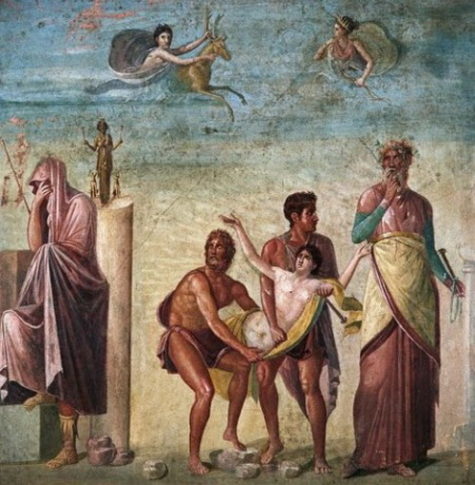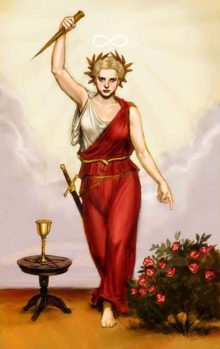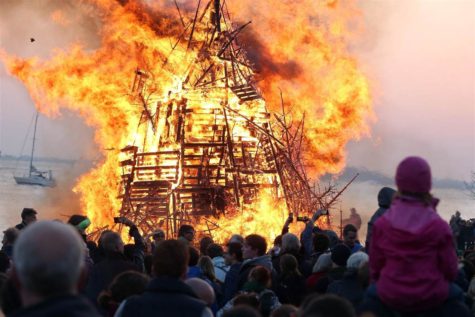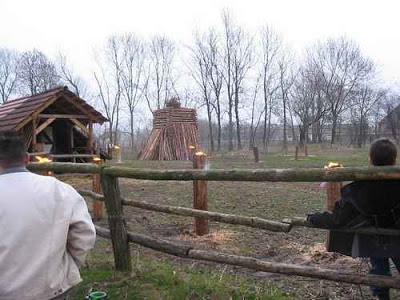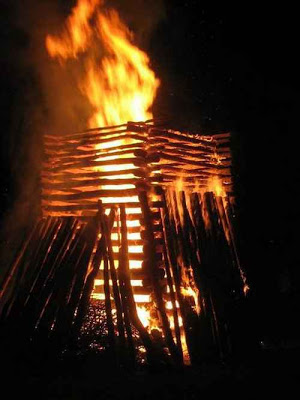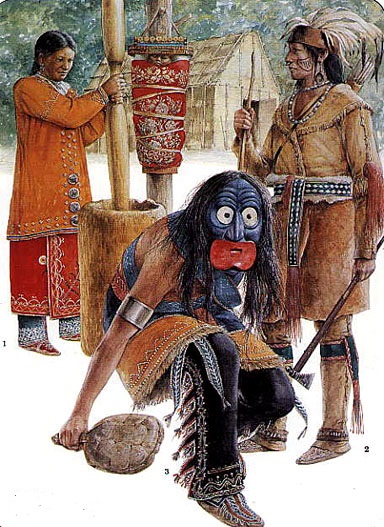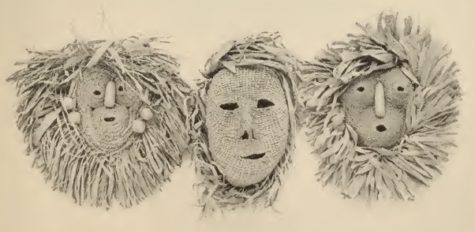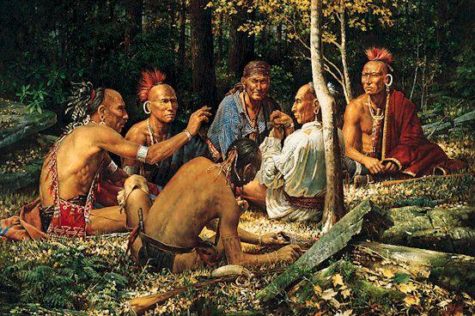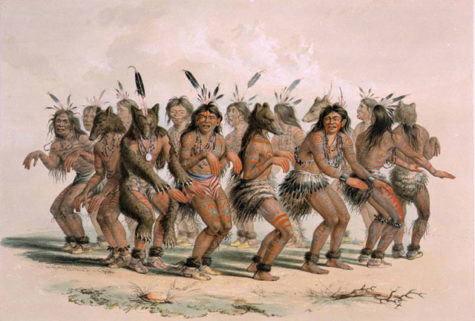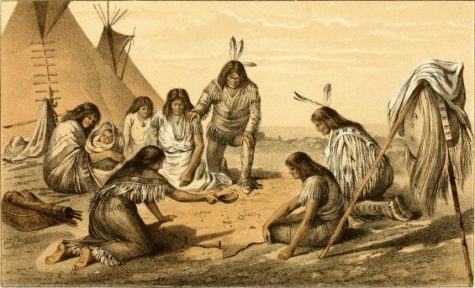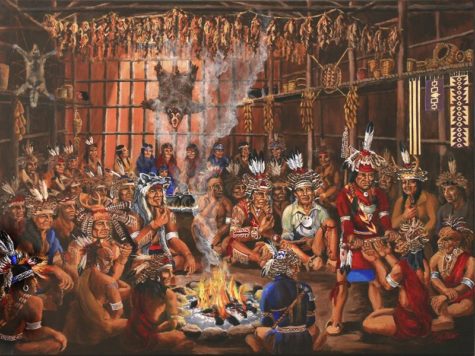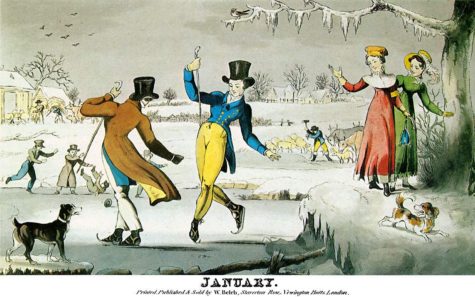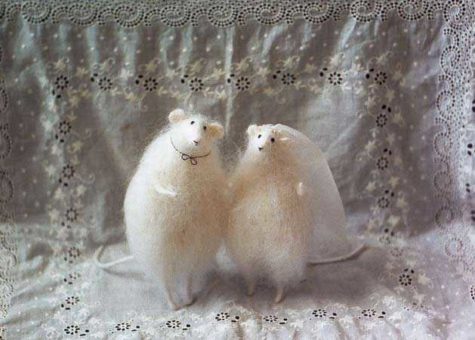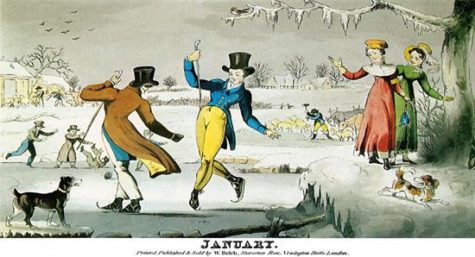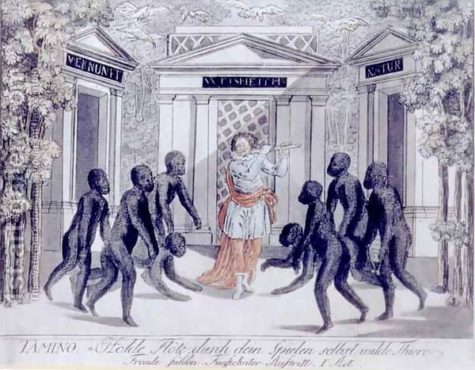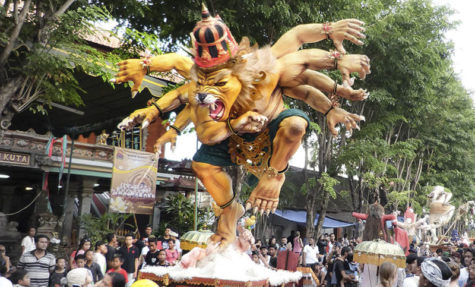Out With The Old
Thargelia (Greek Θαργήλια) was one of the chief Athenian festivals in honour of the Delian Apollo and Artemis, held on their birthdays, the 6th and 7th of the month Thargelion (about May 24 and May 25).
Essentially an agricultural festival, the Thargelia included a purifying and expiatory ceremony. While the people offered the first-fruits of the earth to the god in token of thankfulness, it was at the same time necessary to propitiate him, lest he might ruin the harvest by excessive heat, possibly accompanied by pestilence. The purificatory preceded the thanksgiving service.
The most important ritual was the following. Two men, the ugliest that could be found (the Pharmakoi) were chosen to die, one for the men, the other (according to some, a woman) for the women. Acting as scapegoats for community guilt, they were draped in figs and led through the city. before being cast out.
Hipponax of Kolophon claims that on the day of the sacrifice they were led round with strings of figs on their necks, and whipped on the genitals with rods of figwood and squills. When they reached the place of sacrifice on the shore, they were stoned to death, their bodies burnt, and the ashes thrown into the sea (or over the land, to act as a fertilizing influence). However, it is unclear how accurate Hipponax’s sixth-century, poetical account of the ceremony is, and there is much scholarly debate as to its reliability.
On the first day of the festival, a sheep was sacrificed to Demeter Chloe on the Acropolis, and perhaps a swine to the Fates, but it is generally agreed that an actual human sacrifice took place on this occasion, replaced in later times by a milder form of expiation. Thus at Leucas a criminal was annually thrown from a rock into the sea as a scapegoat: but his fall was checked by live birds and feathers attached to his person, and men watched below in small boats, who caught him and escorted him beyond the boundary of the city. Similarly, at Massilia, on the occasion of some heavy calamity (plague or famine), one of the poorest inhabitants volunteered as a scapegoat. For a year he was fed up at the public expense, then clothed in sacred garments, led through the city amidst execrations, and cast out beyond the boundaries.
After having rid the city of any ill influences on the first day of the festival, the second day begins with a joyous attitude. It follows the basic structure of any other Hellenic festival. First, there was a procession, which included children who carried the eiresione, an olive branch decorated with woolen fillets, bread, fruits, small flasks of honey, and some with oil. The children would sing the following while carrying this:
“The Eiresione brings figs and fat bread,
honey in pots, and oil to rub down,
a cup of strong wine so you go drunk to bed.”
As they moved through the city, they would collect offerings along the way. Once arriving at the temple, the offering of the first fruits of the grain harvest would begin. From the surviving texts we learn that the offering was of two types: a boiled stew of grains and seasonal vegetables, or the loaf of grain bread called the thargelos. It is from the name of the loaf that the festival takes its name. This loaf was also called eueteria, meaning “good year.”
There would also be libations, hymns, much feasting and other activities during the celebration. Singing competitions were especially popular, in which 50 men from the 10 tribes of Athens participated. All of these were done in honor of Apollo, god of purification.
For a more modern approach, we have this idea:
- Themes: Cleansing; Offering; Forgiveness; Magic
- Symbols: Ritual Tools
- Presiding Goddess: As the Greek goddess who created all sacred rituals and ceremonies, Hosia oversees this rite and directs your magical energy toward successful manifestation.
To do Today:
Follow Greek tradition and leave Hosia an offering of fruit, bread, or wheat to encourage her assistance. Next consider creating a personal ritual for cleansing or forgiveness. Hosia will guide your hand in choosing words and actions suited to the working. Alternatively, take out your ritual tools and ask for hosia’s blessing on them saying:
Hosia, these are the tools of my hand, heart, and spirit.
They symbolize the elements and the corners of creation.
Today I ask that you empower them for working magic,
and regulate their use for the greatest good.
May they always direct my energy in perfect love and trust.
So be it.
In ancient Greece, a scapegoat (often a criminal) was often identified to bear the sins for an entire community, then either sacrificed or banished into the wilderness. A way to adapt this practice is by designing an image of something you need to banish, then “driving it away” by putting it in the car and leaving it in a remote spot. As you turn away, ask the goddess Hosia to witness the rite and to empower your efforts for positive change.
Sources: Wikipedia and Pagan Pages and 365 Goddess
From May 19-28 is the time of the Greek festival of Kallyntaria and Plynteria, a time that is also known as a time for “spring cleaning”. Most of us have already started our spring cleaning in various forms, but this particular time of the Sacred Year is dedicated to spiritual cleaning – the cleaning and nurturance of the sacred places.
The Greeks were good at that, and they called this festival Kallyntaria and Plynteria, by which they meant making a special effort to clean the sacred statues of the goddess and god. With all that incense burning and dust gathering, the sacred images get pretty dirty, and you had to take them to be washed in the nearest rivers or lakes, submerging them and letting them reunite with the life-giving waters. Afterward, the women dressed the goddess in her jewels, with much ceremony, and paraded her proudly back to her home in the temple. No singing or fun was allowed during this procedures. These festivals were solomnized because it was work, not play.
The same principle applies to us today. Let’s get those brooms out, and wash the house from top to bottom, really giving it an old fashioned purification. What could be more natural than to transform the old custom of spring cleaning into a religious devotion!
For modern Pagans/Wiccans, now is the time to strip down all the old decorations and adornments of your alter or personal magic space and to do some spring cleaning. If your alter has statues or images of the particular God or Goddess (or both) take them to a local river or stream (if you live near one) and bath the statues in the rushing water. If you are no where near a river, you can use either spring water from bottles, or rushing water from your sink.
If your statues and tools are not made of material safe enough for getting wet, then pass them over pine, frankincense, myrrh, or sandalwood incense. You can also use both water and incense to cleanse your magical wares if you feel it necessary. Clean the dust and and clutter your alter may have accumulated in past celebrations. If you still have Beltane items on your alter, now is the time to remove them and gently store them away for next year.
Celebrate this time of cleaning by partaking of refreshing drinks such as fruit juices like lemonade or limeade. Foods can be on the spicy side, incorporating garlic, onion, and spicy peppers for both purifying and cleansing. Don’t forget to offer some to the Gods :).
From: The Grandmother of Time and Witchbook
The Easter Fire is a custom of pagan origin spread all over Europe. It is a symbol of victory, the victory of beautiful and sunny spring over the cold days of winter.
On Holy Saturday or Easter Sunday, in rare occasions also on Easter Monday, large fires are lit at dusk in numerous sections of Northwestern Europe. These regions include Denmark, parts of Sweden as well as in Finland, Northern Germany, Switzerland, and Austria.
The fire is lit usually on the top of the mountains – Easter mountain, Osterberg – and it is obtained from wood by friction. In Germany, the Easter fire is created by gathering all the Christmas trees and burning them into a huge fire, a sign for everyone to leave behind winter and prepare for spring.
Though not documented before the 16th century, the custom presumably is based on Saxon, pre-Christian traditions, that are still performed each year. There are several explanations of the meaning of these fires. The Saxons believed that around the time of Easter, Spring becomes victorious over Winter. The fires were to help chase the darkness and winter away. It was also a symbol of fertility, which works in a literal sense in that the ashes were scattered over the meadows and thereby fertilized the soil.
The pre-Christian meaning of Easter fires is hardly experienced anymore. Nowadays they are meant to bring the community together, which guarantees a pleasant night combined with the consumption of beer, mulled wine or liquor, and snacks.
Source: Wikipedia
The Iroquois Mid-Winter Ceremony, for continuation of all life-sustaining things is a series of rituals, observed by the six tribes of the Iroquois Confederacy, which celebrates new beginnings and serves as a spiritual new year. The ceremony does not have an official date on the calendar, but rather is determined when the first new moon arrives while both the Ursa Major and Ursa Minor constellations are visible, which occurs in either February or January.
- According to one calendar, this will be Feb 19 thru Feb 28, in 2018.
- According to other star maps, Ursa Major and Ursa Minor can be seen above the horizon in northern areas all year.
The major events of the Midwinter Ceremony consist of the Tobacco Invocation, the Dream Sharing Ritual, the False Face Society, the Peach Stone Game, the Bear Dance, the White Dog Sacrifice, the Great Feather Dance, The Big Heads and the Stirring of the Ashes, and a closing ceremony. These events take place over the course of ten days with no specific order, but generally begin with The Big Heads and the Stirring of the Ashes and ends with a closing ceremony.
- Big Heads and the Stirring of the Ashes
Generally, the first of the activities is the Big Heads and the Stirring of the Ashes. A group of anonymous messengers called the Big Heads visit the tribe’s longhouse. They wear ceremonial outfits made of buffalo skins and braided corn husk masks which symbolize the hunt and the harvest.
They also carry a corn mashing mallet used in the Stirring of the Ashes. In the Stirring of the Ashes, the Big Heads go from house to house stirring the ashes in fire pits of each household while they ask that the New Year brings renewal and fertility to the land. This is gesture of gratitude to “The Creator” as ashes serve as a symbol of the earth and the cycle of life.
- Tobacco Invocation
The next ritual to usually take place after the Stirring of the Ashes is the Tobacco Invocation. It consists of sprinkling tobacco in the embers remaining from the Stirring of the Ashes or outright smoking as an offering. The smoke that rises from the burning tobacco symbolically rises to the heavens to sign of giving thanks and to give messages to the Creator and other spirits.
- Dream Sharing Ritual
The Dream Sharing Ritual serves as a ritual of healing. It serves as a way to get rid of troubling thoughts and a way to make wishes come true as the Iroquois believe that dreams represent ways to resolve real life problems. Tribe members would describe their dreams in front of others so they may give their interpretation of the events that take place in the dreams.
The person who has the best interpretation has to then aid the tribe member in seeing that the issue gets resolved. For dreams that represent physical or mental ailments, they dreamer is sent to the False Face Society which is a group of medicine men.
- False Face Society
The False Face Society is a group of Iroquois medicine men who wear masks made out of wood. These people can consist of either men or women, but only the men wear the traditional masks. They are said to have the ability to scare off the evil spirits that cause illness. Those who are deemed of needing healing during the Dream Sharing Ritual are sent to these medicine men during their gathering. Healing rituals consist generally of blowing or rubbing hot ashes from a fire on those in need of curing.
- Bear Dance
The Bear Dance is another healing ritual that coincides with the False Face Society gathering. It is conducted by both men and women by lumbering and waddling like bear counter clockwise around a person that was ill.
This can be done either privately or publicly. The Iroquois believed that this dance can heal the problems of person that were placed upon them from the previous year.
- Peach Stone Game
The next event is the Peach Stone Game. This game symbolizes the Iroquois creation story where the Creator and his evil brother played a game in competition during the creation of the Earth, the renewal of the Earth like the Stirring of the Ashes, and the battle for survival of crops.
The game consists of six peach pits which are colored black (through burning for example) on one side. They are placed in a bowl and shaken while two teams take turns placing bets in the form of beans on how many black sides will face up. The teams are given an equal number of beans, and the first team to lose all of their beans loses the match. The results of this game are also used to predict the success of the coming year’s harvest.
- White Dog Sacrifice
One of the following events is the White Dog Sacrifice. Originally, this ritual consisted of killing a white dog, a symbol of purity, by strangulation as to leave no marks. The dog was then adorned in red paint, feathers, beads, wampum, and ribbons. It was placed on fire along with tobacco so that smoke may carry their, sacrifice, and prayers to the Creator.
Today, however, the act of killing a white dog is replaced by a white basket due to the animal cruelty in the original proceedings of the ritual.
- Great Feather Dance
The final event before the closing ceremonies is the Great Feather Dance. The dance is held on eight night of the nine-day festival, and serves as way to welcome the new spiritual year as well as thanking the Creator. Dancers wear traditional tribal clothing and turtle shell rattles, and dance to two singers that sit facing each other. They give thanks to all the Creator has bestowed upon them during the previous year by dancing in rhythm and shaking the rattles.
The event finally concludes with a closing ceremony where a speaker presenting an overview of the events and address of thanksgiving. New tribal council members who will lead the people until the next event are chosen and presented to the crowd. By the end of this ceremony, all members of the tribe are purified and a new year is welcomed.
Source: First Nation Rituals
The word January comes from the Roman name for this month; it was named after the god Janus who had two faces. This deity ruled over beginnings and endings, the past and future. Since January is reckoned as the first month of a new year, this connection with the god Janus is appropriate. It is an excellent time to work on putting aside the old and outdated in one’s personal life and making plans for new and better conditions.
Correspondences for January:
- Nature Spirits: gnomes, brownies
- Herbs: marjoram, holy thistle, nuts and cones
- Colors: brilliant white, blue-violet, black
- Flowers: snowdrop, crocus
- Scents: musk, mimosa
- Stones: garnet, onyx, jet, chrysoprase
- Trees: birch
- Animals: fox, coyote
- Birds: pheasant, blue jay
- Deities: Freyja, Inanna, Sarasvati, Hera, Ch’ang-O, Sinn
Power flow: sluggish; below the surface; A good time for spell work having to do with beginning and conceiving; protection; reversing spells; conserving energy by working on personal problems that involve no one else; getting your various bodies to work smoothly together for the same goals.
January Celebrations and Rituals:
The Chinese use the concept of putting aside the old and outdated in one’s personal life and making plans for new and better conditions in celebrating their New Year, which occurs on the first day of the New Moon when the Sun is in Aquarius. They considered this celebration a time for settling debts, honoring ancestors, and having family reunions. They carry paper images of dragons through the streets and set off fireworks to chase away evil entities and misfortune.
Tsao-Wang was the Chinese kitchen god or deity of the hearth and domestic comfort; his picture hung above the stove. He was the protector of the family and recorder of their actions and words. His report at the end of each year to the Heavenly Jade Emperor was said to determine the family’s coming fortune. Because of this, the Chinese burned the old picture-image and put up a new one a few days before New Year. His wife had the task of reporting on female family members.
Even the people of Tibet, whose year began about the end of January, had a celebration for expelling the Old Year. They made a dough image for the demons to inhabit, then worshiped them for seven days. At the end of that period, they took the image outside the village to a crossroad and abandoned it. The idea behind this seems to have been that the negative beings who had accumulated during the Old Year, received recognition for their existence, but also received a firm statement, by the action of leaving their image outside the village, that they were not welcome to hang around.
Most cultures had some ceremony for ending an old cycle of the calendar and celebrating the beginning of a new cycle. Physical activity acknowledging the end and beginning of cycles sets off similar changes in the subconscious mind. This change in the subconscious is necessary in order for actual physical changes to come about. Such rituals are helpful when one faces the end of cycles in relationships, career, residence, or other life situations.During the Feast of Kore, which was held at night with much feasting and dramatics, a group of initiates bearing torches went down into the goddess’s underground chamber. With much ceremony and reverence, they brought out the wooden statue of Kore, naked except for her golden jewelry. The statue was placed on a decorated litter and carried seven times around the temple. The Greeks considered that the number seven brought luck and success.
The Incan festival of Camay Quilla was held at the New Moon.
The Seven Deities of Luck in Japan were honored during a three-day festival called San-ga-nichi. To avoid good luck being swept away, there was no sweeping during this festival. These Seven Deities are also called Shichi Fukujin or Shichi-Kukujin, which means “Seven Gods of Happiness.” There are six gods and one goddess that make up this little group. They sail about in a treasure ship called a takarabune.
This ritual is linked to chasing away mice from the house and village and is observed on different days in different areas. In many places, this coincides with the Day of Martyr Nestor of Thessalonica, (October 27), or the day after the Day of the Archangel Michael (November 8th).
On this day, no one should utter the word ‘mouse,’ lest.they hear their name and decide that they have been invited to stay at or come to your house. This day is traditionally honored by women. No household work is done, so that mice do not harm the house or the grain. Skirts are sewn up the front and the back as a symbolic “sewing up” of the mice’s eyes. Fireplaces might also be (temporarily) sealed, so that the eyes and mouths of the mice are similarly covered.
Then the Mice Wedding is performed. Calling them “lad” and “lady”, a male and a female mouse are dressed as bride and groom and married in a ritual typical to a human wedding of the region. They are then placed in a basket and marched through the village in a solemn procession, The newly weds are then taken far as away from the village where they are set free, or more commonly, taken to the river and ceremonially drowned.
The idea being that the other mice in the village would be inspired to follow the procession out of the village. Marriage was the most common cause of a change in place to live, and by all means a wedding is the prerequisite for establishing a new home and a new family. Alternatively, the other mice would be so frightened by the sudden drowning of the happy couple that they would never return to the village.
If however, despite the ritual performed on Mice’s Day, the little rodents still managed to breed in hordes, it was considered a sign that someone was secretly stealing something away from the household, either food or household items. And in most cases suspicion fell on daughters-in-law and young farmhands who were not blood relations.
A cautionary tale:
Once a married man was taking away more items and clothes on the sly to give them to his mistress. Once his wife found out about the betrayal, she took the matter to the judge. The judge summoned the disloyal husband and demanded an explanation. The man denied the whole time, until finally the wounded wife blurted out the last and uncontested proof, namely that the mice in the house had bred in unusually high numbers. Then the cheating husband admitted his shame and confessed he was taking those gifts to another woman.
Another common explanation of the phenomenon of mice that continued to breed was that the family members were in discord, either daughters-in-law quarreled with one another, or refused to respect their father and mother-in-law, or possibly, the sons did not obey their own fathers’ will.
Collected from various sources
January starts the year with a plethora of fun, frolicsome festivity. The new year in particular is celebrated by at least 170 nations. In terms of energy, January focuses on beginnings. It’s a time for personal renewal, starting any beloved project, and sustaining those things already in progress.Magic for health, protection, and prosperity is particularly augmented by working during this month. It’s also good time for spell work having to do with beginning and conceiving; protection; reversing spells; conserving energy by working on personal problems that involve no one else; getting your various bodies to work smoothly together for the same goals.
Weather Watching:
It is said that whatever the weather is like the first twelve days of January indicates what the weather will be like for the next twelve months. Each day equals one month in succession.
January Birth Signs
(Celtic, Nordic, Astrological, etc)
- Dec 22 to Jan19 – Sun in Capricorn
- Dec 22 to Jan 21 – Sign of the Carnation Flower
- Dec 23 to Jan 1 – Sign of the Apple Tree
- Dec 24 – Jan 21 – Sign of the Birch Tree
- Jan 1 to Jan 11 – Sign of the Fir Tree
- Jan 12 to Jan 24 – Sign of the Elm Tree
- Jan 21 and Feb 19 – Sign of the Orchid Flower
- Jan 21 to Feb 19 – Sun in Aquarius
- Jan 21 – Feb 17 – Sign of the Rowan Tree
- Jan 25 to Feb 3 – Sign of the Cypress Tree
January – the month of new beginnings. January was introduced into the Roman calendar by a legendary king of Rome, Numa Pompilius (c. 715 – 673 BCE), who named it in honor of Janus, the god of doors and openings, beginnings and endings.
Since January is reckoned as the first month of a new year, this connection with the god Janus is appropriate. It is an excellent time to work on putting aside the old and outdated in one’s personal life and making plans for new and better conditions.
When former president Tabaré Vázquez created the ‘Día del nunca más’ (‘Never Again Day’) in 2006, he envisaged it drawing a line under the:
“horror of the recent past to salve the open wounds left by the dictatorship”
Ten years on and it is a safe bet that the ‘Never Again Day’ will in fact never be celebrated again.
I love the idea of a “Never Again Day.” It didn’t work for President Vázquez of Argentina, but maybe it could work on a personal level for those of us who need to take some time to make note of and work to change our most familiar patterns of self destruction.
Toward the end of March, the people of Tibet had a ceremony to expel the demons of bad luck from their homes, lives, and communities. The people of Bali, which is east of Java, also hold public expulsions of demons at least once a year, and on a new moon.
Each village sets food at the nearest crossroads and then goes to the local temple. Everyone prays and blows horns to summon the demons. Then people begin to bang on anything that will make a loud noise, thus frightening the entities which flee the area.
The demons can’t resist the food, pause at the crossroads, and are ambushed by a priest who curse them. This final ambush causes the evil demons to leave the area, and order is restored.
You can duplicate this ritual at home by leaving food on your front doorstep. The food is not going to come back into your home – so leave it on a paper plate instead of your good china.
Then go through the house, calling and whistling to summon the demons. You will want to sound very musical and inviting. Flutes and pan pipes were often used for this purpose.
When you have gone through every room of your home, and you feel that you have attracted the attention of every bad spirit in your home, suddenly begin banging on pots and pans making a loud noise. Have someone stationed at the door, and when the loud noise begins, have them open the door.
The noise will frighten them, but the bad luck entities of the house won’t be able to resist stopping for the food. Now, use this charm to send them packing:
Off with you spirits of fear, spirits of poverty, spirits of evil, spirits of anger, spirits of unhappiness, spirits of pain, spirits of death.
(You can add to this list and personalize it as much as you’d like.)
Repeat three times – each time louder and more commanding than the last.
Give way to the sun, and the moon,
For this is a sanctuary,
This is a place made safe.
Repeat three times – starting with a loud commanding voice and then diminishing in volume but increasing in determination.
Now, very dramatically and decisively, shut the door and lock it. Say:
Blessings and peace upon us,
Blessings and peace.
Repeat three times – smiling.
Very Important:
Do not bring the food you left on the doorstep back into the house, rather, take it away and leave it in a dumpster or put it by a crossroads not close to your home.
Note: This post was put together by Shirley Twofeathers for Gypsy Magic, and has been moved to my new website, here at shirleytwofeathers.com. You may repost and share without karmic repercussions only if you give me credit and a link back to this website. Blessed be.
In Bali, the last day their 210 day Saka calendar marks the Balinese feast of purification. This is the time of the year when the lord of hell cleans out his underworld lair, and all manner of demons and evil spirits are left to roam Bali free.
During this time….when evil is afoot……the natives go to elaborate lengths to purify both their individual homes as well as the island. No corner or stone is left untouched as rites of purification and spells for protection are recounted
On this Saka New Year’s Eve, it is all blaring noise and merriment. Every Balinese household starts the evening with blessings at the family temple and continues with a ritual called the pengrupukan where each member participates in ‘chasing away’ malevolent forces, known as bhuta kala, from their compounds – hitting pots and pans or any other loud instruments along with a fiery bamboo torch.
These ‘spirits’ are later manifested as the ogoh–ogoh to be paraded in the streets. As the street parades ensue, bamboo cannons and occasional firecrackers fill the air with flames and smoke. The Nyepi Eve parade usually starts at around 19:00 local time.
This date varies from year to year, in 2019, it falls on March 6. It is based on the Saka calendar of western Indian origin, one among the many calendars assimilated by Indonesia’s diverse cultures. The Saka is 78 years behind the Gregorian calendar, and follows a lunar sequence.
If you’d like to honor this tradition, here is a simple house cleansing ritual:
You will need a broom, some sea water, or rain water with some sea salt dissolved in it, and an Asperger (optional). Open all the windows and doors in your house and starting from the center sweep the whole house. Move Deosil (clockwise) as much as possible. As you go, visualize all negativity as a wispy grey cloud which you are driving out through the windows and doors.
Now take your salt water (and Asperger if you have one) and sprinkle the salt water around the boundaries of your whole home, making sure that you include the sills of all the doors and windows. Be very careful not to make everything too wet, or to sprinkle any electrical equipment, switches or sockets, etc.
As you do each door or window say: “I mark this boundary that no negativity be allowed to enter here. Blessed be.” and then close it.
If the weather is really inclement you may need to work room by room rather than doing the whole house in one go. In this case make sure you cover the boundaries between rooms and any passageways, stairs, etc. without windows.
Note: This house cleansing ritual can be used at any time.
Whenever you move into a new home it is as well to cleanse it to remove any residual negative energies which may have been left behind by the previous occupants. You may also like to do this after any period of upset in your home to thoroughly drive out the problem, or if you have been visited by someone who seems to have left some of their negativity behind them.
Sources:
